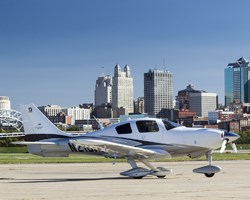General aviation rebound?
After suffering through a punishing recession, the general aviation market is showing signs of life, which is good for composites.

The Cessna TTx, formerly known as the Corvalis, is an all-composite aircraft. (Source: Cessna.)
The General Aviation Manufacturers Assn. (GAMA, Washington, D.C.) held its 2014 “State of the Industry” event on February 19 at the Newseum in Washington, D.C. (here’s a link to the Webcast of the event: www.gama.aero/media-center/movie-%E2%80%93-ga-manufacturing/2014-state-industry-webcast). Charles Spence of General Aviation News, publisher of the daily General Aviation newsletter, was at the event, and these are his observations, published online on March 19.
General aviation might be seeing some light at the end of the long tunnel of decline, according to comments from officials from GAMA at their annual “state of the industry” press conference. GAMA, which now reports world-wide data, shows that 50 percent of GA deliveries last year were in North America. GAMA officials note that the Asia-Pacific market is growing, while the European/Middle-East also is improving. Much of the growth, however, has been in the turboprop and pure jet markets. Turbo-props showed a 34 percent gain over 2013.
The single-engine piston market posted a production of 933 aircraft, a slight increase of 2.1 percent over last year. Piper Aircraft accounted for 154 — 16 percent — of those 933 planes produced last year. Agricultural aircraft also showed an increase, indicating a growing acceptance of GA’s role in food production.
GAMA executives point to ways they see a brighter future. Steve Taylor, president of Boeing Business Jets and chairman of GAMA, and Pete Bunce, president and CEO of GAMA, said general aviation is getting better acceptance in other parts of the world. Much of this acceptance is in the business aircraft market, but as this segment grows, the light piston market also should increase. China is also recognizing the importance of general aviation aircraft to serve its many smaller and remote areas and is pushing for more airports and less restrictive regulations.
Manufacturers find the biggest dollar volume in production of corporate aircraft, but expect growth in this market will also result in benefits and growth for light GA planes. There are at least two reasons for this. First, the current fleet of piston aircraft is 48 years old, and will have to be replaced. Second, efforts to change the certification of aircraft and parts can produce better aircraft at lower cost.
Increased regulations and slow activity by regulators, plus an increase in lawsuits, have cost companies heavily, causing them to increase prices far beyond the rate of inflation. Since 1994, there have been 800 new regulations that manufacturers must meet, GAMA officials said.
In 2007 manufacturers started looking for ways to reduce production costs. “We wanted to drive down the costs for both the government and industry,” Taylor and Bunce said. A rulemaking committee was formed and began looking at ways to streamline and standardize regulations. With the FAA, they coined the term “Double the safety at half the cost.” Manufacturers began working more on Congress. Key legislators were invited to visit plants. General aviation caucuses were formed and today these caucuses have more members than any other groups.
Both political parties passed the Small Airplane Revitalization Act, signed into law last year by the President. This act set specific deadlines for actions to be taken. A deadline of 2015 was set for the FAA to come up with new regulations. GAMA spokesmen said this means the proposals must be finished by the end of this year to enable the FAA to have all of 2015 to process changes through the long government process.
So, is GAMA correct? Are things looking brighter for general aviation? Probably. However, streamlining regulations is just one of the issues keeping GA busy looking for solutions. There is also an airport problem. The city of Santa Monica showed this recently when it wanted to close that city’s busy general aviation airport. GA use of airports in busy areas like Atlanta, Los Angeles, Chicago, New York and other hub locations might face new and possibly restrictive requirements if NextGen succeeds in making it easier and faster for commercial airlines to get from city to city, further crowding limited airport facilities.
There is a glimmer of light at the end of the tunnel, but it will need consistent and persistent efforts to help it glow into the future all pilots want.
Here’s a link to Spence’s original newsletter article: generalaviationnews.com/2014/03/19/light-at-the-end-of-a-long-tunnel-of-decline/?utm_source=The+Pulse+Subscribers&utm_campaign=f3f0a2954e-TP2013&utm_medium=email&utm_term=0_62525a9780-f3f0a2954e-13534
Related Content
Plant tour: Albany Engineered Composites, Rochester, N.H., U.S.
Efficient, high-quality, well-controlled composites manufacturing at volume is the mantra for this 3D weaving specialist.
Read MorePlant tour: Joby Aviation, Marina, Calif., U.S.
As the advanced air mobility market begins to take shape, market leader Joby Aviation works to industrialize composites manufacturing for its first-generation, composites-intensive, all-electric air taxi.
Read MoreNext-generation airship design enabled by modern composites
LTA Research’s proof-of-concept Pathfinder 1 modernizes a fully rigid airship design with a largely carbon fiber composite frame. R&D has already begun on higher volume, more automated manufacturing for the future.
Read MorePlant tour: Middle River Aerostructure Systems, Baltimore, Md., U.S.
The historic Martin Aircraft factory is advancing digitized automation for more sustainable production of composite aerostructures.
Read MoreRead Next
Developing bonded composite repair for ships, offshore units
Bureau Veritas and industry partners issue guidelines and pave the way for certification via StrengthBond Offshore project.
Read MoreAll-recycled, needle-punched nonwoven CFRP slashes carbon footprint of Formula 2 seat
Dallara and Tenowo collaborate to produce a race-ready Formula 2 seat using recycled carbon fiber, reducing CO2 emissions by 97.5% compared to virgin materials.
Read More“Structured air” TPS safeguards composite structures
Powered by an 85% air/15% pure polyimide aerogel, Blueshift’s novel material system protects structures during transient thermal events from -200°C to beyond 2400°C for rockets, battery boxes and more.
Read More




















